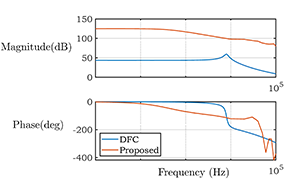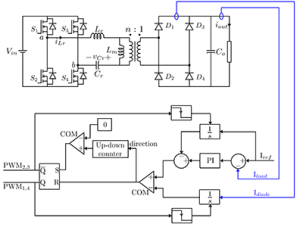Control architecture for LLC resonant converter
PhD student Anuj Maheshwari with Advisor K. Haran
An LLC series resonant dc-dc converter is an attractive solution for the dc-dc conversion stage in many applications, including battery charging, solar energy harvesting, and LED driver, due to its high efficiency and power density, and low electromagnetic interference over a wide load range. The controller design for LLC resonant dc-dc converter is challenging due to the large number of poles whose locations vary with operating conditions. A controller’s ability to reject input disturbance is required to reduce the input filter size and increase power density. Also, the high bandwidth of the controller allows for a fast transient response. The control architecture, shown in Figure-1, utilizing the output diode current measurement essentially reduces the control-to-output transfer function for an LLC resonant converter to first order and provides a very high degree of input voltage disturbance rejection with a minimal increase in control-loop complexity. Analytical and simulated frequency response for control-to-output transfer function, shown in Figure-2, validate the first order behavior of the converter.

Fig. 2. Analytical (a) vs simulated (b) bode plots for control to output transfer function for conventional direct frequency control (DFC) and proposed control architecture. The bode plots match quite well, but the simulated bode plot starts to deviate when frequency becomes comparable to switching frequency.

